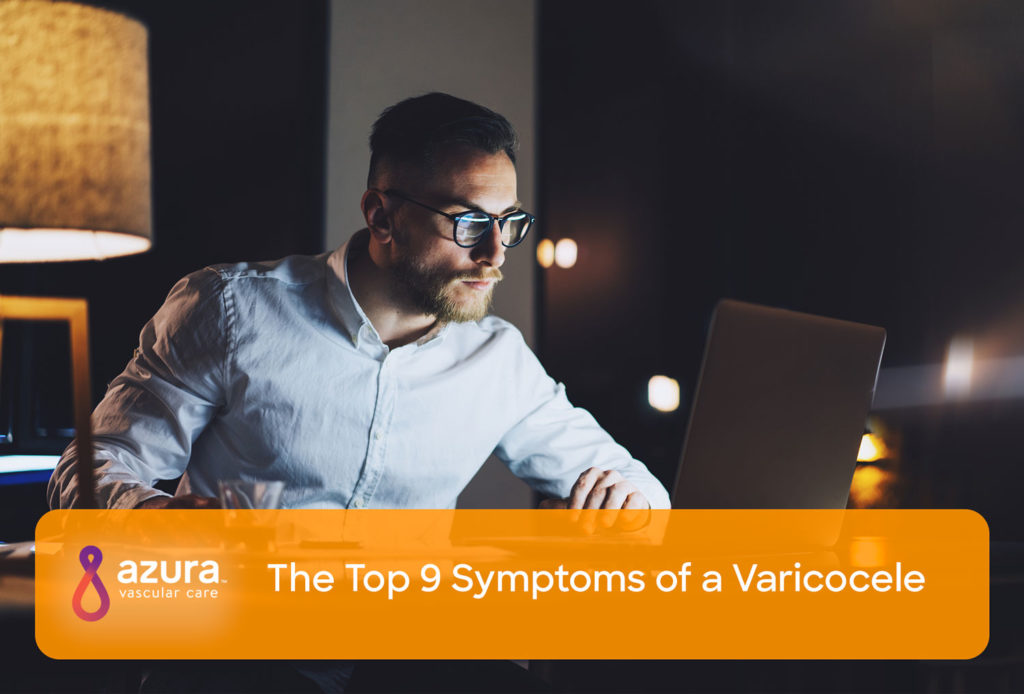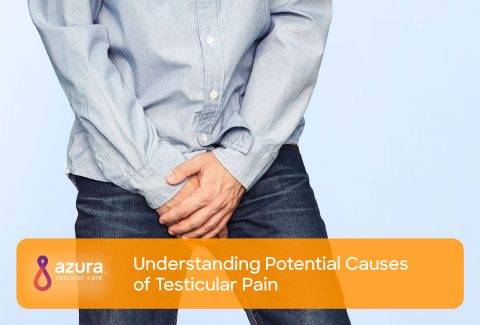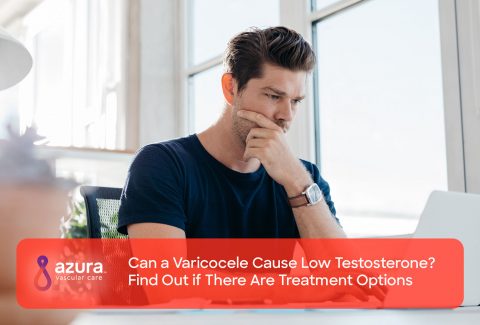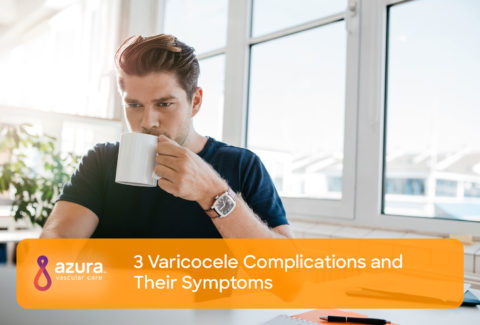
A varicocele is a group of enlarged veins in your scrotum, the pouch of skin that holds your testicles in place.[ii] Varicoceles are usually the result of incompetent or faulty valves in the veins in your scrotum. Often, they cause no symptoms at all. However, if you do have any varicocele symptoms, they’ll fall into one of three groups.
Usually, if you experience any symptoms of a varicocele they will be in one of the following categories:
- The look and feel of your scrotum
- Pain in the groin or scrotum caused by your varicocele
- Systemic problems such as male factor infertility and low testosterone levels
Let’s look at the top nine symptoms of a varicocele occurrence by first discussing what you might notice in terms of the look and feel of your scrotum.
1. Enlarged veins in your scrotum. A varicocele is a group of enlarged veins that often looks or feels like a bag of worms.
2. One testicle is larger than the other. Typically, the smaller testicle will be on the side of your scrotum that has the varicocele. And most often – 85% of the time – varicoceles develop on the left side of the scrotum due to the position of the veins on that side.
3. A lump in your testicle that doesn’t hurt. Any time you find a lump in your testicle or scrotum, you should have it checked by your doctor as soon as possible. However, if the lump you’re feeling is in fact a varicocele, it likely won’t cause pain.[i]
While varicocele pain is not common, it can occur, especially as the varicocele becomes larger. Pain will typically take on the following characteristics.
4. An uncomfortable, dull ache in your scrotum. This ache is caused by the pooling of blood in your scrotum. Supporting your varicocele with a jockstrap or briefs, rather than boxer-style underwear, can sometimes help ease the discomfort.
5. Pain that gets worse the longer you stand and gets better when you lie down. The longer you’re on your feet, the longer blood pools in your varicocele. Lying down can help the blood drain from your scrotum, thus relieving pain.
6. Pain that’s worse after prolonged or strenuous exercise. Prolonged and strenuous exercise can strain venous circulation, causing more blood to pool.
7. Pain that gets worse in hot weather. Hot weather can cause veins to dilate or become larger, making it more difficult for the affected veins to pump blood back to your heart.[i, ii, iii]
RELATED: Why Does My Testicle Hurt?
For some men, the other two varicocele complications are more troublesome, and have to do with systemic issues such as sperm and testosterone production, both of which occur in your testicles.
8. Infertility. Sperm is produced in your testicles. It’s thought that the enlarged veins that make up a varicocele keep the temperature in or around your testicles higher than normal. Doctors believe this may affect sperm production, motility (movement) and function, leading to the potential for lower fertility or male factor infertility. In fact, varicoceles are a leading cause of problems in four out of 10 men experiencing infertility issues.[iv] Some researchers also believe that there is an autoimmune component to infertility in conjunction with a varicocele. That is, your own body may start to kill off sperm. According to at least one study, the chances of this occurring are higher in men with varicoceles than in those without.[v]
9. Low testosterone. Doctors also know that varicoceles can interfere with the actual production of testosterone. In addition to infertility, low testosterone production can result in many problems, including:
- Inability to get a firm erection
- Low sex drive
- Depression
- Fatigue or lack of energy
- Lack of ambition
- Difficulty sleeping
- Trouble concentrating
- Decreased exercise tolerance
- Hot flashes
- Decreased muscle mass
- Increased fat mass [iii]
It’s clear that some varicocele symptoms are more serious than others. For example, low sperm and testosterone production can be quite serious for men who are trying to start or grow their family. Other symptoms of a varicocele, however, are more aesthetic, such as a lump on your scrotum that feels and looks like a bag of worms.
If your varicocele symptoms persist, become bothersome or get worse, or if you’re concerned you may have issues with sperm or testosterone production, you should make an appointment to see your doctor. Varicoceles that are causing symptoms can be corrected through surgery, or, for men hoping to avoid a surgical procedure, they can be treated through a minimally invasive technique known as varicocele embolization. This procedure offers quick recovery, and is successful in about 90% of cases. [vi] You don’t have to live with a varicocele – there are safe, effective treatment options available.
Sources:
[i] UCLA Health (2017) Varicocele Symptoms. http://urology.ucla.edu/body.cfm?id=478&action=detail&ref=19
[ii] Young Men’s Health (2017). Varicoceles. http://youngmenshealthsite.org/guides/varicoceles/
[iii] Mayo Clinic (2017). Varicoceles. http://www.mayoclinic.org/diseases-conditions/varicocele/basics/definition/con-20024164
[iv] Urology Care Foundation (2017). What is a varicocele? http://www.urologyhealth.org/urologic-conditions/varicoceles
[v] Bozhedomov, V., Lipatova, N., Rokhilov, I., Alexeev, R., Ushakova, I. “Male fertility and varicocele: role of immune factors.”, 2013. Andrology. 2(1); p. 51-58. http://onlinelibrary.wiley.com/doi/10.1111/j.2047-2927.2013.00160.x/full
[vi] Halpern, J., Mittal, S, Pereira, K., Bhatia, S., Ramasamy, R. “Percutaneous embolization of varicocele: technique, indications, relative contraindications, and complications.”, 2015. Asian J. Androl. 18(2); p. 234-238. https://www.ncbi.nlm.nih.gov/pmc/articles/PMC4770492/


